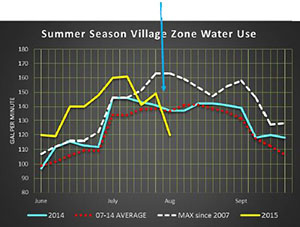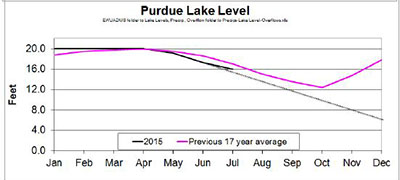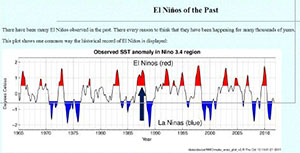Despite continuing dry weather, EWUA’s position is improving
— from Paul Kamin —
Thank you to all those who are efforting to be more mindful of their water use.
EWUA has been able to “encourage” a number of our highest users to significantly cut back on their irrigation. We found the top 10 accounts with the greatest increase in water use were creating the equivalent demand of adding 80 new homes to the water system this summer.
Plans for bringing more capacity online for next summer are in the works, along with developing ways to equitably allocate cost to the highest users, not the normal users.

EWUA member’s water use pattern is in a good spot right now. Please continue with your helpful efforts.
Tracking Summer Water Demand
After early summer’s unprecedented demand, EWUA’s members have responded to our outreach efforts. Water use has moderated, and returned to “normal summer levels.” The last week of July brought the first measurable rainfall in months. You’ll notice the significant drop in demand following last weekend’s rain.

This is not a reason to relax our diligence. It is reassurance that your efforts do matter, and do make a difference!
Purdue Lake Water Levels
More good news. After an early summer where declining lake levels caused serious concern, the rate of decline has slowed. By lowering our rate of withdrawal, the water level at Purdue is .4’ (about 5”) above our warning level. It remains 1’ below the 17 year average, but is no longer at alarming levels.
What About Groundwater Levels in our Aquifer?
EWUA is closely monitoring water levels from multiple wells in and around Eastsound. We are not detecting a below normal decline in aquifer levels. At this point we no not detect evidence that our aquifer is being over-withdrawn! Of course we will continue to monitor. Changes in Groundwater levels lag behind surface water (lake levels).
 History of El Nino on Orcas
History of El Nino on Orcas
This fall and winter’s weather will be “influenced” by El Nino, which is associated with warmer than normal water temperatures in the Pacific. El Nino’s impact on the Pacific NW is projected to be warmer and DRIER than normal for at least the next 6 months. These forecasts raised questions about how past El Nino events have impacted Orcas. The adjacent [below] chart shows the most recent El Nino Events in the last 50 years.
EWUA studied the precipitation data from the Olga weather station. Olga has data dating back more than a century!
Past El Nino year’s often were accompanied by lower than normal rainfall during the fall and winter when Orcas depends on precipitation to recharge our lakes and aquifers. The 1987 El Nino event (dark blue arrow on chart) was associated with the lowest Orcas rainfall in the last 100 years. That year rainfall was only 60% of normal. The optimist would say that if the worst drought in 100 years still has 60% of normal rainfall, that’s not so bad (or is it?).
The Next Question is, How Would 60% of Normal Precipitation During the Upcoming Fall and Winter Impact EWUA?
Purdue Lake was developed in 1980. Every winter since 1980 the Lake has filled and overflowed. The lowest recorded overflow was 17 million gallons. (The max was 110 MG!) 17 million gallons of overflow is equivalent to +10 ft of lake level. The lake is 20’ deep so 10 additional feet of “overflow” even in lean precip. years is “comforting”.
60% of normal precipitation is associated with the once-in-a-hundred-year drought. What would the impact on Purdue be in we only had 60% of normal precipitation? EWUA’s projections suggest that Purdue will still fill to capacity this winter, even with this diminished precipitation. Many other Washington water systems will not refill their reservoirs this winter with only 60% of normal precip.
This is important. Based on this research, EWUA is comfortable with the ongoing drawdown at Purdue through the remainder of the summer. We are confident that Purdue will fill again this winter, as it always has. We don’t imagine needing to save water this summer to be used next summer. We can “reasonably expect” that next summer’s water will still fall from the sky this winter.
Please note, EWUA is making predictions based on historic data. We do not have crystal balls!
What Created This Summer’s 20% Increase in Water Demand?
This was an interesting investigation. EWUA compared June and July 2014 consumption data to this summer’s. The 20% increase in water use was real. There was some increase across the board. However, what we have found is that there were a small number of accounts that were responsible for a very large share of the increased water use. As was stated earlier 10 accounts’ increase in water use was equal to the water use of 80 average homes.
EWUA has “been in communication” with the members responsible for the largest increases in water use. There have been positive reactions. There has been some reduction in use patterns. Other’s have said they “need the water.” The EWUA Board is considering policies to better encourage the highest water users to be more attentive to their impact on the water system. More details of these plans will be forthcoming when fully vetted.
Regional Drought Responses
The water systems serving Everett, Seattle, and Tacoma (and most of the smaller municipalities in between) have all issued water alerts. They are noticing the same patterns that EWUA has been witnessing. Elevated use (in the 20% range) and reservoir decline greater than normal.
Friday Harbor is also sharing the same stories. Skagit River withdrawals for agricultural irrigation have been halved by the State, with more cuts likely.
The “Drought of 2015” is spreading its impact across Washington State.
Staff Appreciation
I do want to appreciate the EWUA staff who have religiously collected and organized mountains of data points over the past decades. This work makes the type of studies we have been sharing with you possible. No prediction is better than the data it is based on. Lake levels, aquifer levels, precipitation level, production levels, meter readings, water temperatures and on and on. It is time consuming and not the exciting portion of what we do, but it is important, and that importance is coming to the fore during this drought. Thanks guys!
**If you are reading theOrcasonian for free, thank your fellow islanders. If you would like to support theOrcasonian CLICK HERE to set your modestly-priced, voluntary subscription. Otherwise, no worries; we’re happy to share with you.**









Paul and staff:
Thank you for these updates.
Thank you very much for giving us so much detail about trends and present situation; glad to know reducing toilet flushing and saving shower and sink rinse water to water my plants outside is worth the effort because i know I am not the only one striving to make our water source go farther.
Thanks to everyone. There are even a few rain drops sprinkling as I write this to ‘say” hallelujah!